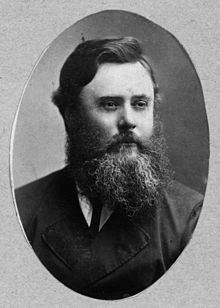Nationality Scottish Occupation Grazier, explorer Parents Andrew Petrie | Children 9 Name Thomas Petrie | |
 | ||
Died August 26, 1910, Shire of Pine Rivers | ||
Thomas Petrie (31 January 1831 – 26 August 1910) was an Australian explorer, gold prospector, logger, grazier and protector of Aborigines.
Petrie was born at Edinburgh, fourth son of Andrew Petrie and brother of John. His family travelled to Sydney, arriving in October 1831 and his father entered the government service as a supervisor of building. They moved to Moreton Bay (subsequently Brisbane) in 1837, where Thomas was educated by a convict clerk and allowed to mix freely with Aboriginal children. He learnt to speak the local language, Turrbal and was encouraged to share in all Aboriginal activities. He was witness to convicts labouring in chains on the government farms along the river and saw numerous floggings of convicts on Queen Street. Petrie was also in the crowd that watched the first hangings at the settlement in 1841, that of the aboriginal men Nungavil and Mullan at The Old Windmill. At 14 he participated in a walkabout to a feast in the Bunya Mountains. He was accepted by the Aboriginals and was often used as a messenger and invited on exploration expeditions. He also learned about surveying, bushcraft and the local geography while travelling with his father.
In 1851 Petrie prospected for gold in the Turon region of New South Wales and spent the next five years on Victorian goldfields, "finding only enough gold to make a ring". He returned to Brisbane a number of times and saw the botched public hanging of Dalla man Dundalli in 1855 at Wickham Park. Petrie married Elizabeth Campbell in 1859 and shortly after the marriage, Petrie sought the advice of a local aboriginal elder named Dalaipi for a good place to start a cattle station. Dalaipi's son, Dal-ngang showed him their ancestral land at Mandin (North Pine River) and offered it to Petrie. Dal-ngang expressed indignation when told this land had already been acquired by the Griffens as part of the Whiteside station. Petrie, after consulting with Mrs Griffen bought a ten square mile (26 km²) section of the property in the Pine Creek district and named it Murrumba, an aboriginal word meaning "good place". Aboriginals helped him to clear his land and build his farm buildings.
On 26 June 1861, Thomas Petrie appeared at the proceedings of the Select Committee on the Native Police Force to give evidence. Petrie's views on aboriginals had hardened by this stage as he was supportive of both the composition and continuation of the force, even though he admitted that many aboriginals around his residence had been shot by the detachment under Frederick Wheeler based at Sandgate. He also said that aboriginals were definitely cannibals and that they should be forbidden to go into Brisbane unless they had 'a pass or accompanied by their masters.' He claimed that he paid aboriginals that worked for him in clothing only, as they would otherwise spend money on alcohol and that it was commonplace for aboriginals to be paid for their labour with rum.
Petrie continued to look for new timber and places suitable for European settlement. In 1862, he headed to the Maroochy River area with a group of 25 aboriginals that included Ker-Walli, Wanangga and Billy Dingy. On this journey, he became the first white man to climb Buderim Mountain and also ventured up the tributaries of the Maroochy River looking to exploit the large cedar growing there. At Petrie's Creek, he established a logging camp which was run by aboriginal labour. At this camp, Petrie branded his original 25 aboriginal workers with his logging symbol by using a piece of glass. He later surveyed a route from Cleveland to Eight Mile Plains. He also arranged for some Aboriginals to welcome the Duke of Edinburgh in 1868. In 1877 the Douglas ministry established Queensland's first Aboriginal reserve on Bribie Island with Petrie as its chief adviser and overseer, but the reserve was closed in 1878 by colonial secretary Palmer.
Petrie died at Murrumba, survived by his wife who died aged 90 on 30 September 1926 and by two sons and five daughters of their nine children. Though Murrumba had been reduced to 3000 acres (12 km²) the family kept the property until 1952. In 1910 the name of the North Pine district was changed to Petrie in his honour and the next year a free-stone monument was erected in the township and unveiled by Sir William MacGregor. There is also a new suburb in the area named Murrumba Downs.
In 1904 Tom Petrie's Reminiscences of Early Queensland was published, written by his daughter, Constance Campbell Petrie. The book is regarded as one of the best authorities on Brisbane's early days.
